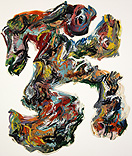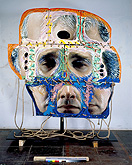News
Anderson Gallery receives key works
-
 Print
Print -
 Comments
(1)
Comments
(1)
-

Charles Clough, H.K., 1980, mixed media, from the Dorothy and Herbert Vogel Collection, 2010
-

Karel Appel, Study for a Portrait of Donald Kuspit, 1988, acrylic, oilstick, mirror, Polaroid and rope on wood, gift of Harriet Appel-de Visser, 2009
UB’s Anderson Gallery has received major donations to the university’s permanent collection, including nearly 400 works by Buffalo native Charlie Clough donated by Dorothy and Herbert Vogel, and an imposing bust of the art critic Donald Kuspit by the Dutch artist Karel Appel, which was donated by his widow, Harriet Appel-de Visser.
“Study for a Portrait of Donald Kuspit” and selections of Clough’s paintings from the Vogel gift currently are on view in the UB Anderson Gallery.
A founding member of Hallwalls Contemporary Arts Center in 1974, Charlie Clough has long played a central role in the Western New York arts community. He met the Vogels in 1978 when he moved to New York City.
Known for their devotion in following the careers of the artists they collect, the Vogels assembled a comprehensive representation of Clough’s prints, drawings and photographs. The breadth of the donation demonstrates the evolution of the artist’s self-proclaimed life project, the “photographic epic of a painter as a film or ghost,” or PEPFOG, that he has pursued over four decades. From his early paint creatures featuring magazine clippings embedded into irregularly shaped paper cutouts covered with brightly colored swirling paint to his big finger paintings of the late 1990s in which cosmic vortexes emanate from large-scale canvases, Clough’s systematic approach to the various manifestations of PEPFOG is rooted in the interplay between the history of painting and its mediated representation.
In the mid-1960s before the dominance of the commercial gallery, the Vogels began amassing an important collection of 20th-century American art, one that was especially strong in minimal and conceptual works—with forays into post-minimal expressionistic work and figuration by artists like Clough. They were able to acquire the work on Herbert Vogel’s earnings as a postal clerk—Dorothy’s salary as a librarian went toward living expenses—by forging strong friendships with artists early in their careers and collecting mostly works on paper that could easily be taken home with them in subway or cab.
In 1991, the Vogels began donating work to the National Gallery, which in turn, has helped find institutions committed to the care and preservation of contemporary art to place additional works.
“The UB Anderson Gallery is honored to be among the museums to receive donated artworks from these prestigious and generous collectors,” says Sandra H. Olsen, director of the UB Art Gallery.
The works by Clough from the Vogel donation will be featured prominently in a survey exhibition of his work to be organized by the UB Art Gallery in the Center for the Arts for spring 2012.
The Dutch artist Karel Appel (1921-2006), who helped found the vividly rebellious, post-World War II European art movement Cobra in 1948, was supported by the Martha Jackson Gallery throughout the 1950s and 60s.
Upending the geometric decorum of de Stijl, Appel’s early work, along with that of the Cobra group, bursts with expressionistic color spontaneously applied. Standing more than 10 feet high, Appel’s “Study for a Portrait of Donald Kuspit” (1988) is more controlled. Appel fractures an enlarged photograph of the critic’s deadpan expression into quadrants of wooden blocks sutured together with ropes and outlined in pop colors to effect an uneasy sensation of the subject moving back and forth between a real being and dreamlike apparition.
This monumental work complements the extensive holdings of Appel prints in the UB Anderson Gallery’s collection.
“In addition to its important contribution to the collection, this donation reflects international recognition of the Martha Jackson Gallery Archives in the UB Anderson Gallery and research by UB graduate students,” Olsen notes. “The gift was given, in part, to thank the UB Anderson Gallery for research assistance received by the Karel Appel Foundation.”
Other work recently acquired by the UB Art Galleries includes Tibetan Thankga paintings and other Buddhist objects from the Collection of Richard V. and Susan Lee, which enhances the global cultural materials in the Annette Cravens Collection; Richard V. Lee, photographs of Tibet (1994); Arnold Mesches, “FBI Files 54” (2003) from Jill Cement; Harvey Breverman, “Portrait of Allen Ginsberg” (1991) from Myles and Diana Slatin; and “Ant Farm, Architectural Plan of Citizens’ Time Capsule” (1975) from David Katzive.

Reader Comments
Liz Rywelski says:
I especially like the part where, "They were able to acquire the work on Herbert Vogel’s earnings as a postal clerk—Dorothy’s salary as a librarian went toward living expenses—by forging strong friendships with artists early in their careers and collecting mostly works on paper that could easily be taken home with them in subway or cab." It's inspiring and regardless of income more young people should collect art.
Posted by Liz Rywelski, Art <3+ers , 05/21/11